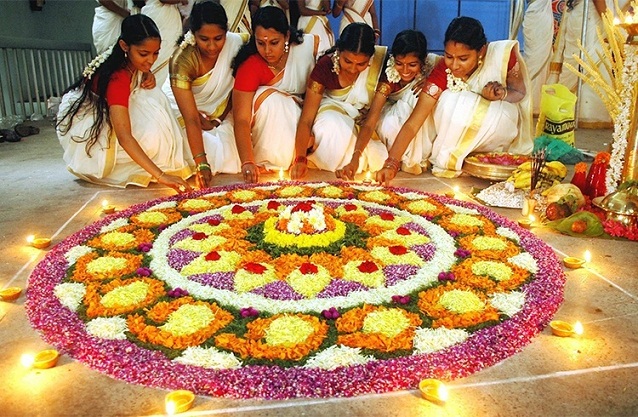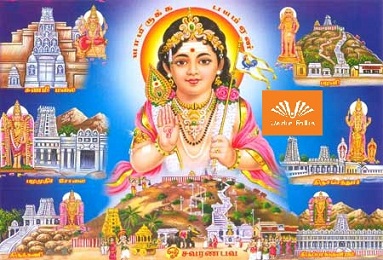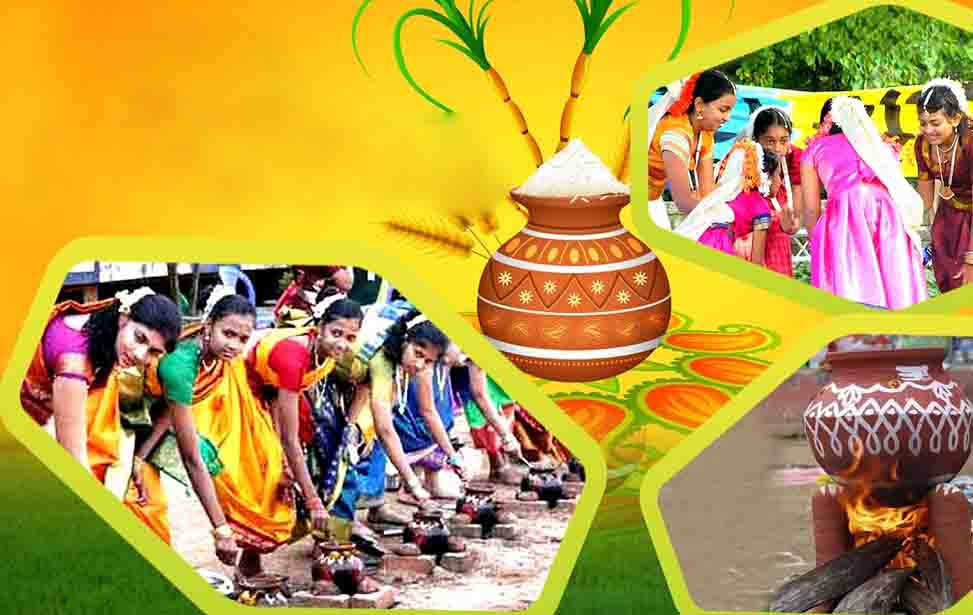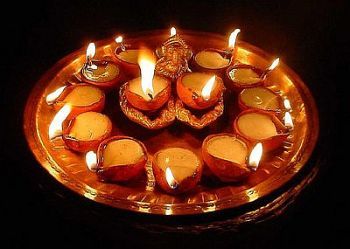Main God : Lord Vishnu
Observed by : Malayalis
Type : Hindu festival
Significance : Harvest festival
Observances : Boat Race, Kaikottikali Dance
Festival :
Onam is a Hindu festival celebrated by the people of Kerala. Onam is Malayali festival which is celebrated by native speakers of Malayalam. Onam day is decided based on Solar Calendar. Onam is celebrated in Chingam month on Malayalam Solar Calendar. Chingam month is known as Simha month in other solar calendars and Avani month in Tamil Calendar. The day when Nakshatra Thiruvonam prevails in month of Chingam is considered for Onam celebrations. Thiruvonam Nakshatra is known as Shravana in other Hindu Calendars.
The festival commemorates the appearance of Vamana avatar of Vishnu and the subsequent home coming of the legendary Emperor Mahabali. Onam celebrates the Asura King Mahabali’s annual visit from Patala (the underworld). On Thiruvonam day, Asura King Mahabali is believed to visit every Malayali home and meet his people.
The celebrations of Onam start on Atham day (the day when Atham Nakshatra prevails) and continue for 10 days till Thiruvonam day. Atham Nakshatra is known as Hasta Nakshatra in other Hindu Calendars.
Rituals and activities :
Onam falls in the month of Chingam, which is the first month according to the Malayalam Calendar. The celebrations begin within a fortnight of the Malayalam New Year and go on for ten days. All over the state of Kerala, festive rituals, traditional cuisine, dance and music mark this harvest festival. The ten-day Onam festival is considered to be flagged off with Atthachamayam (Royal Parade on Atham Day) in Thripunithara (a suburb of Kochi City).The parade is colourful and depicts all the elements of Kerala culture with more than 50 floats and 100 tableaux. The main centre of festival is at Vamanamoorthy Thrikkakara temple within Kochi City, believed to be the ancient capital of King Mahabali. The temple is dedicated to Lord Vamana and is directly linked to the mythological background of Onam.
The ten days of Onam are celebrated with great fanfare, by Malayalees. Of all these days, most important ones are the first day, Atham, and the tenth and final day, Thiru-Onam (Thiruvonam). The rich cultural heritage of Kerala comes out in its best form and spirit during the festival.
Pookkalam :
The floral carpet, known as ‘Onapookkalam’,is made out of the gathered blossoms with several varieties of flowers of differing tints pinched up into little pieces to serve the decorator’s purpose. It is considered a work of art accomplished with a delicate touch and a highly artistic sense of tone and blending. When completed, a miniature pandal (umbrella) hung with little festoons is erected over it. The pookkalam is similar to Rangoli which is made of powders of various colors and is popular in North India.

Traditionally, Atthapookalams (pookalam made on the Atham day) included flowers endemic to Kerala and the Dashapushpam (10-flowers), but nowadays all varieties of flowers are used. Earthen mounds, which look somewhat like square pyramids, representing Mahabali and Vamana are placed in the dung-plastered courtyards in front of the house along with the Pookalam, and beautifully decorated with flowers. In the recent years, the floral designs have evolved from the traditional circular shape to unique designs depicting different cultural and social aspects of Kerala life. All over Kerala, Pookalam competitions are a common sight on Onam day.People start putting atha-pookalams from Atham ( First day of 10-day festival ) till thiruvonam, while only some put Onam Pookalams till the 28th day after thiruvonam.
Onam Sadya :
The Onam sadya (feast) is another very indispensable part of Thiruvonam,and almost every Keralite attempts to either make or attend one. The Onasadya reflects the spirit of the season and is traditionally made with seasonal vegetables such as yam, cucumber, ash gourd and so on. The feast is served on plantain leaves and consists of about 26 dishes, including (but not limited to)
Chips (especiallyBanana chips)
- Sharkaraveratti (Fried pieces of banana coated with jaggery)
- Pappadam
Various vegetable curries such as
- Injipuli(also called PuliInji)
- Thoran
- Mezhukkupuratti
- Kaalan
- Olan
- Avial
- Sambhar
- Dalserved along with a small quantity of ghee
- Erisheri
- Molosyam
- Rasam
- Puliseri (also referred to as Velutha curry)
- Kichadi (not to be confused withKhichdi) and Pachadi (its sweet variant)
- Moru (Curd with water)
- Pickles, both sweet and sour
- Two different types of buttermilk
- A chutney powder prepared from grated coconut
- A series of dessert calledPayasam (a sweet dish made of milk, sugar, jaggery and other traditional Indian savories) eaten either straight or mixed with a ripe small plantain.

The curries are served with rice, usually the ‘Kerala Matta’ parboiled rice preferred in Kerala.
In hotels and temples, the number of curries and dishes may go up to 30. The importance of the feast to the Kerala’s Onam celebration culture is captured in the famous Malayalam proverb “Kaanam Vittum Onam Unnanam” which means “One must have the Onam lunch even selling his property, to have so”.The Travancore-style Onasadya is renowned to be the most disciplined and tradition-bound.There is usually an order followed in serving the dishes, starting from the chips and pickles first. However, different styles and approaches to making and serving the dishes are adopted in various parts of Kerala depending on local preferences.
Music and dance :

Traditional dance forms including Thiruvathira, Kummattikali, Pulikali, Thumbi Thullal etc.are performed as part of celebrations all over Kerala at this time. Thiruvathirakali is a women’s dance performed in a circle around a lamp, and is given special importance during Onam. Kummattikali is a famous and colourful-mask dance. In Thrissur, festivities includes a procession consisting of caparisoned elephants surrounded by Kummatikali dancers. The masked dancers go from house to house performing the colorful Kummattikali.
Kathakali dance is also commonly performed during this time, with dancers enacting famous mythological legends.A famous venue for this is at Valluvanad which is associated with the growth of Kathakali,and Cheruthuruthy, where Kerala Kalamandalam is located.

Thiruvathira Kali during Onam in Kerala
Pulikali, also known as Kaduvakali is a common sight during Onam season. This dance showcases performers painted like tigers in bright yellow, red and black, who dance to the beats of instruments like Chenda and thakil.
Performances of the ritual worship dance Theyyam are given during the Onam season. In this, Mahabali is played by the Onathar. Its variations include characters such as Oneswaran and Onapottan.

Pulikali (Tiger dance) in Thrissur At the Thrikkakara temple, every day of the festival showcases one or more of these activities including Kathakali, Thiruvathira, Chakyar koothu, Ottam thullal, Patakam, Onam songs and percussion instrument shows.The Onasadya here is grand in scale, and is attended by over ten thousand people from all religions and faiths.
Boat Race :
The Vallamkali (the snake boat race) is another event that is synonymous with Onam. Well-known races include the Aranmula Uthrattadhi Boat Race and the Nehru Trophy Boat Race. About 100 oarsmen row huge and graceful snake boats and men and women come from far and near to watch the snake boats skim through the water.

As a tribute to the traditional snake boat race, a similar snake boat race is also held by the Malayali diaspora in Singapore annually during Onam at the Jurong Lake.






